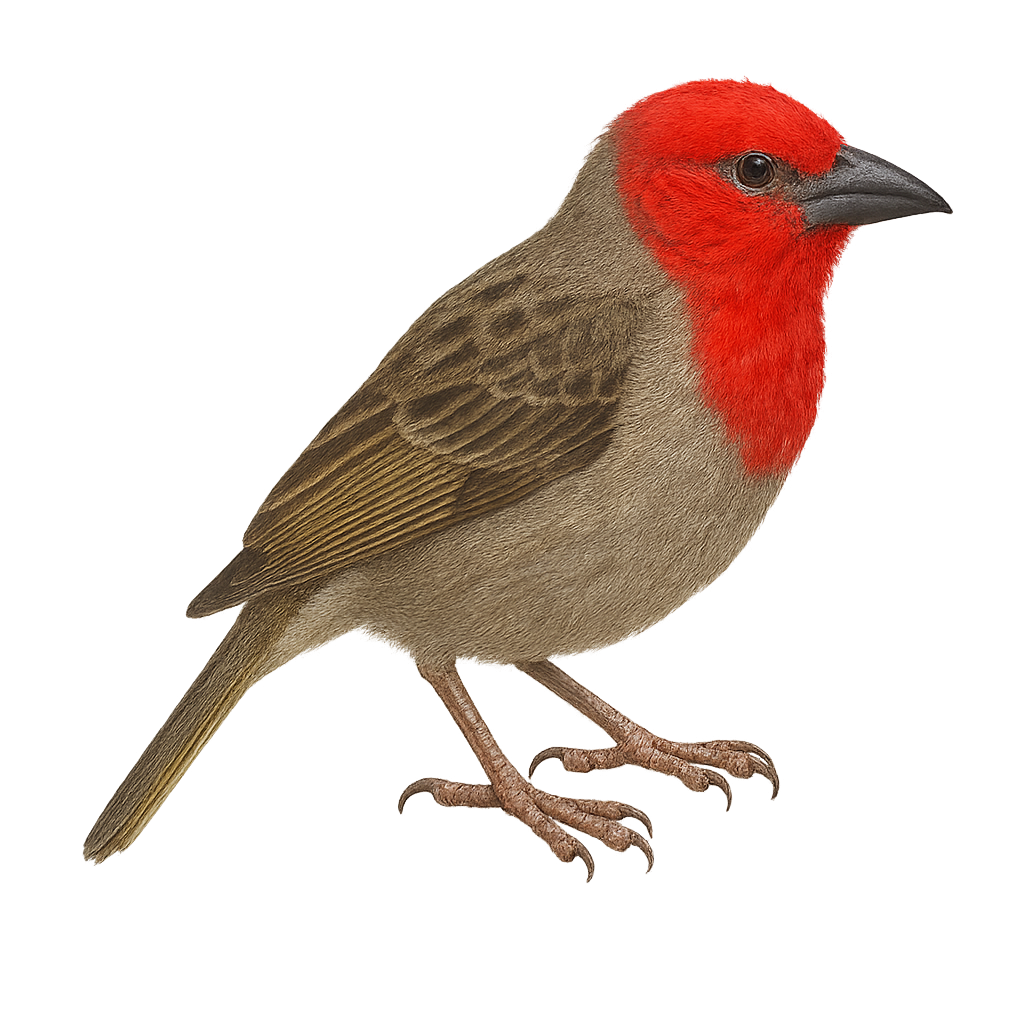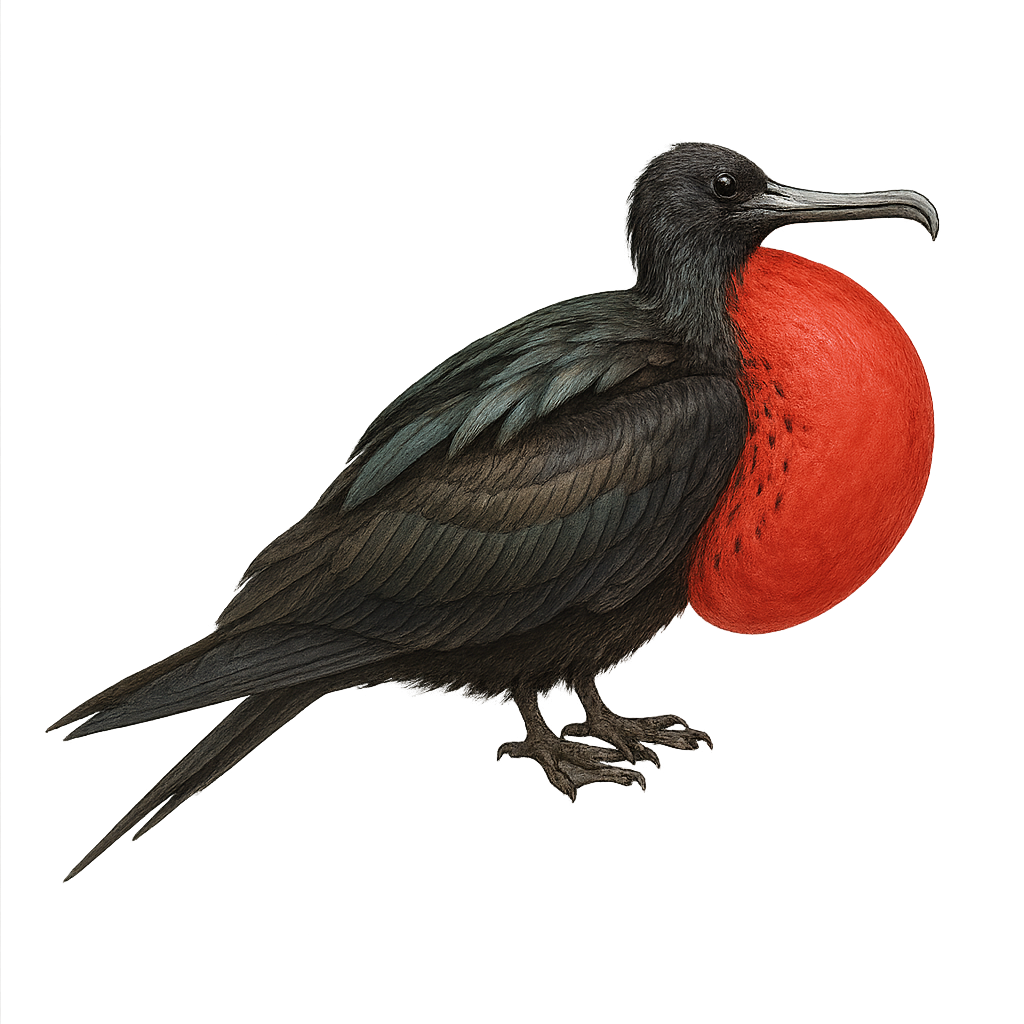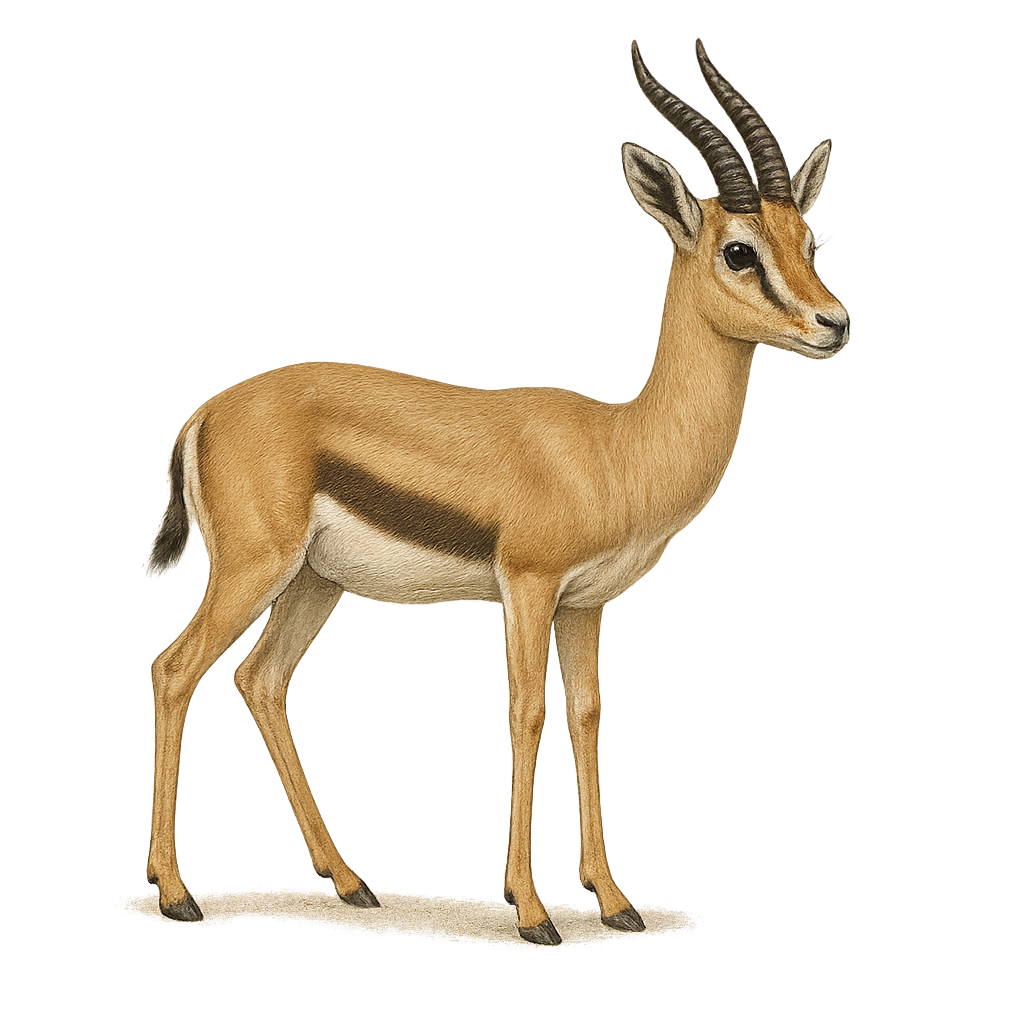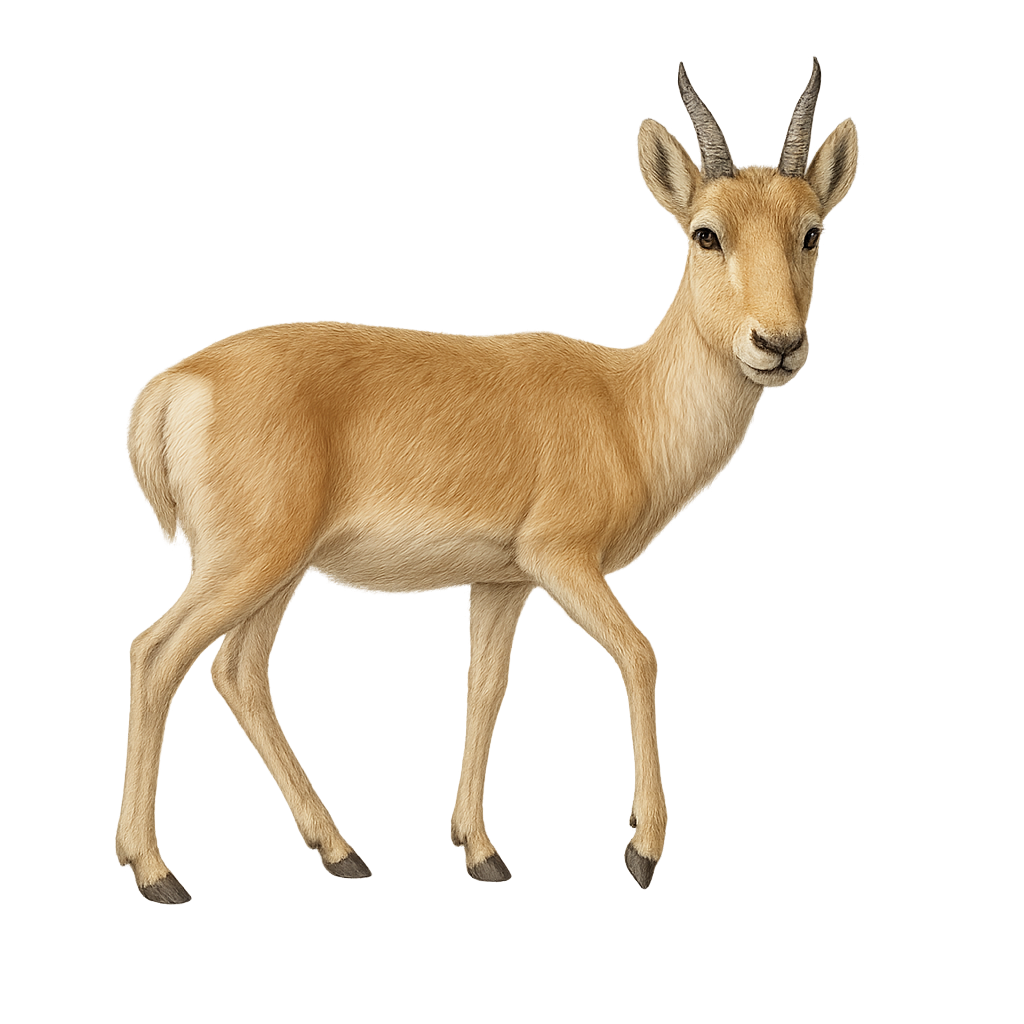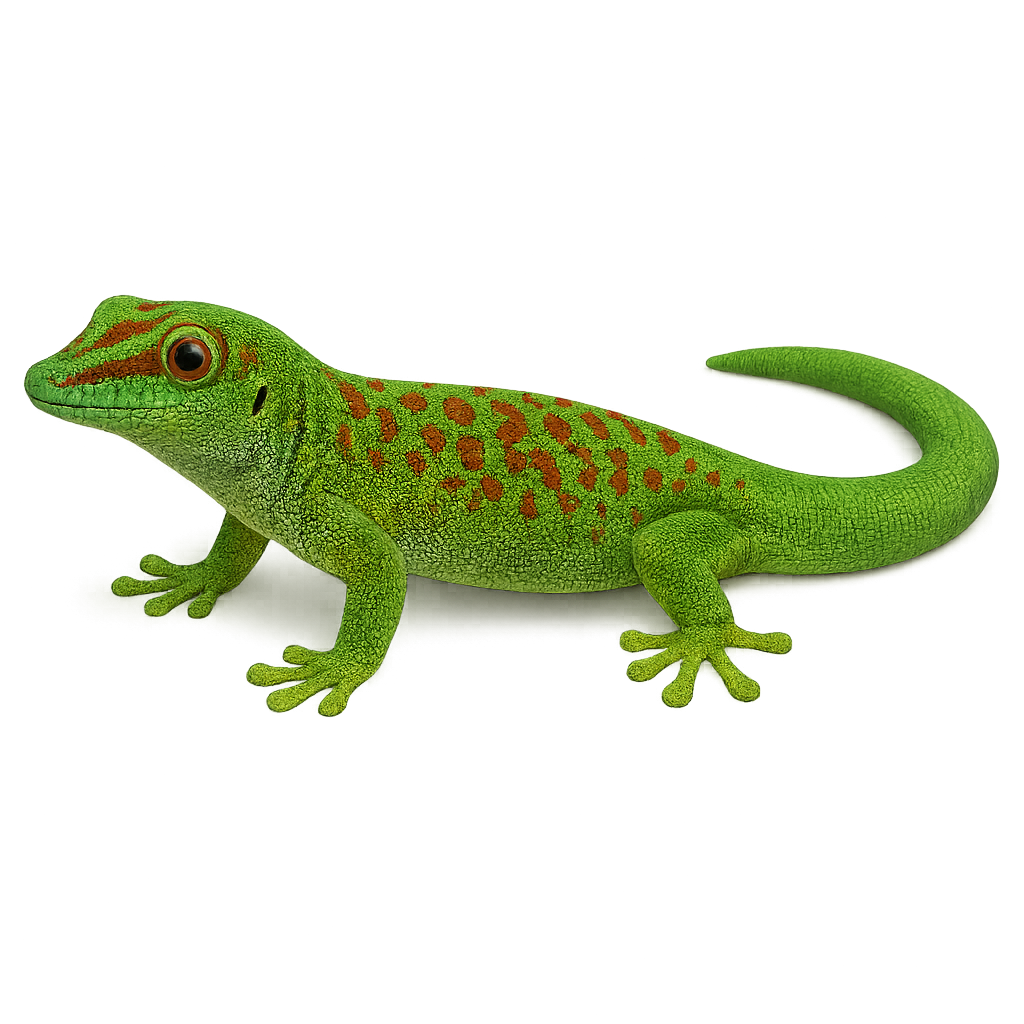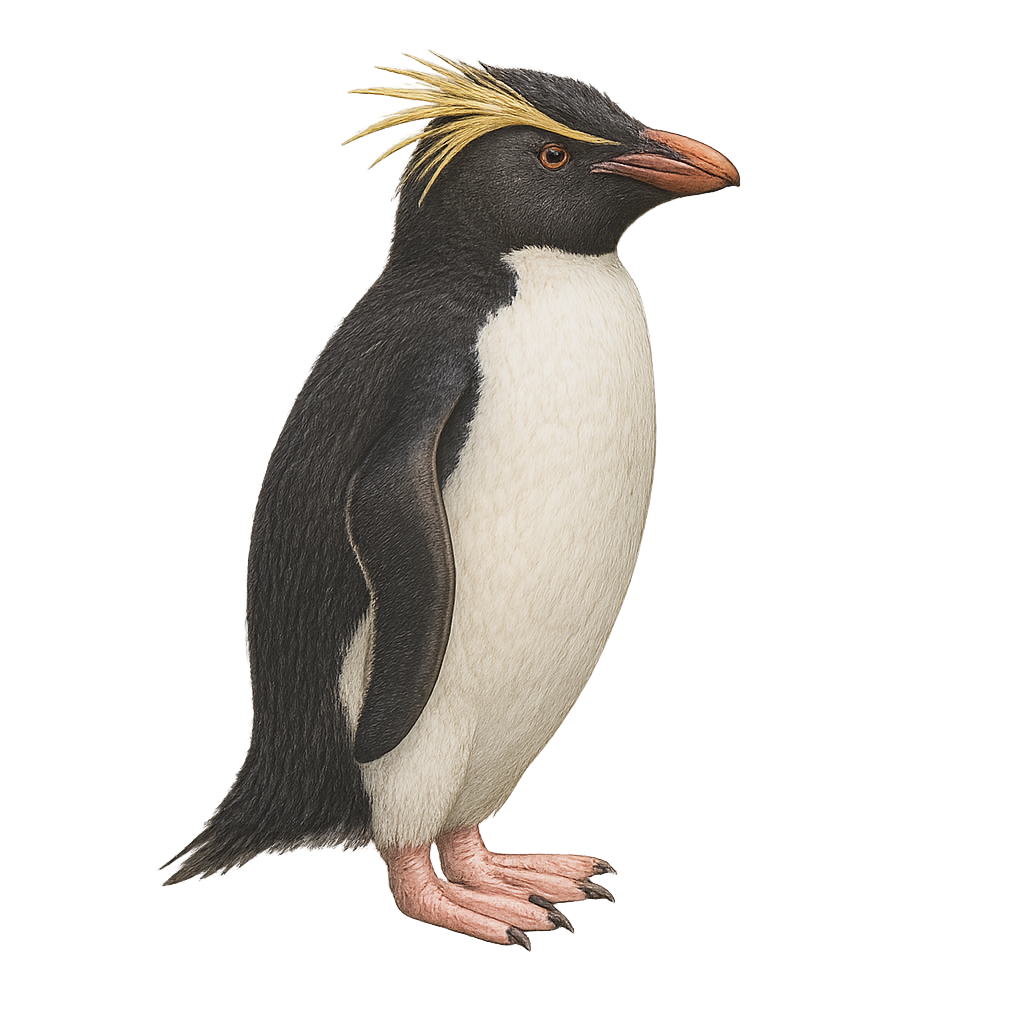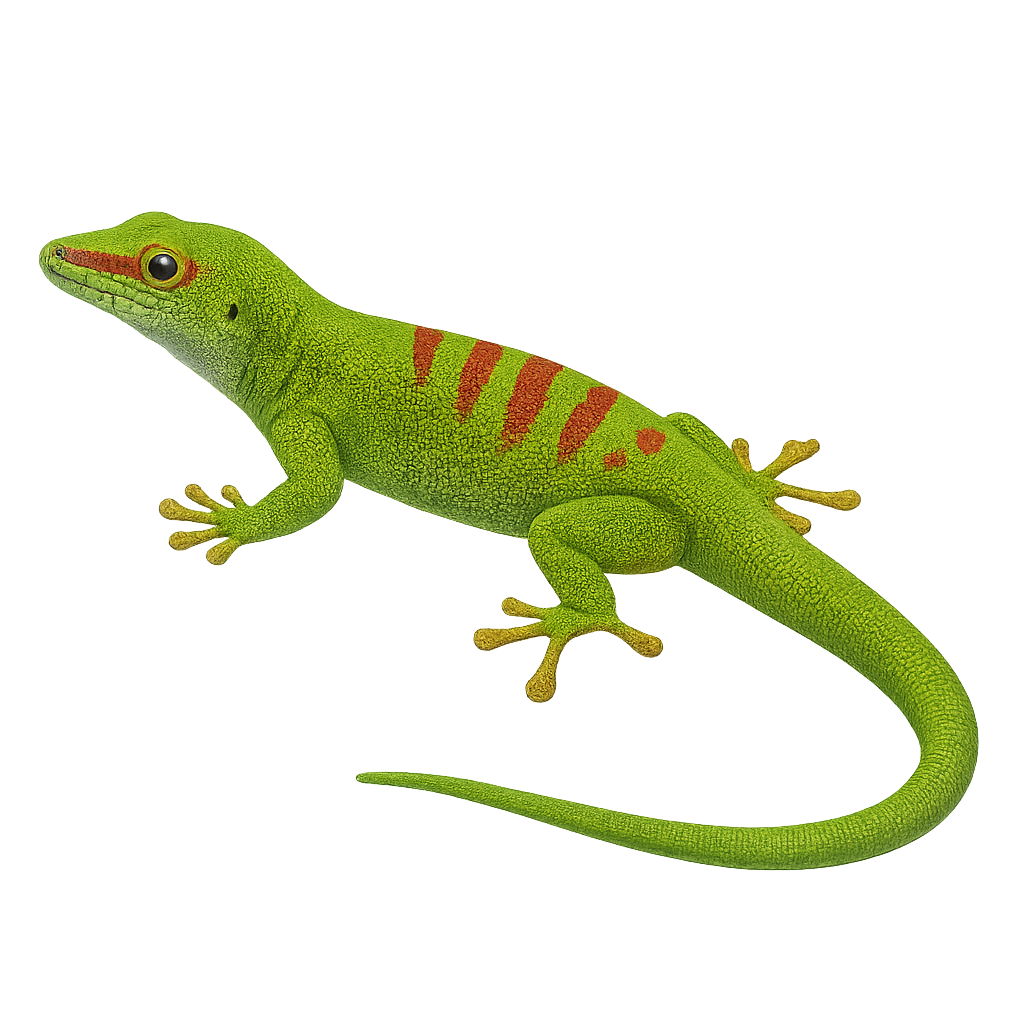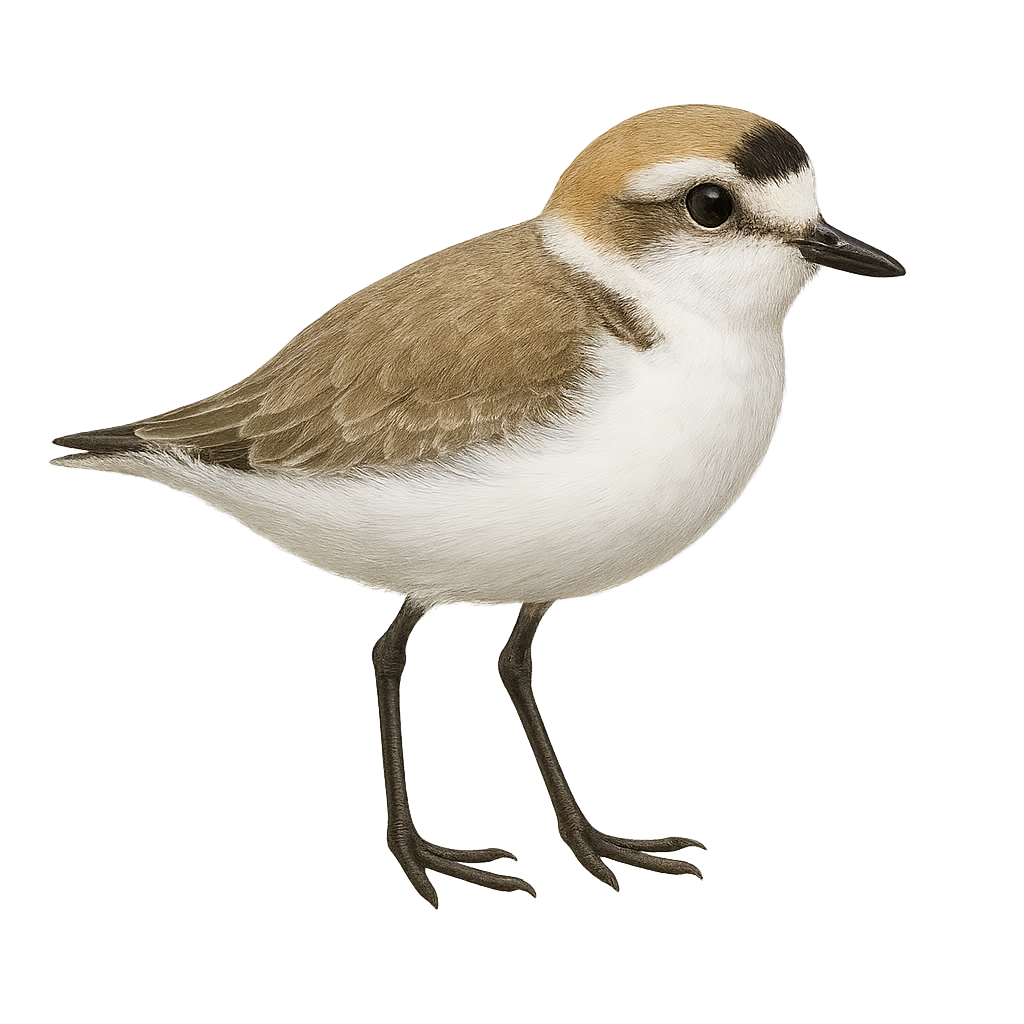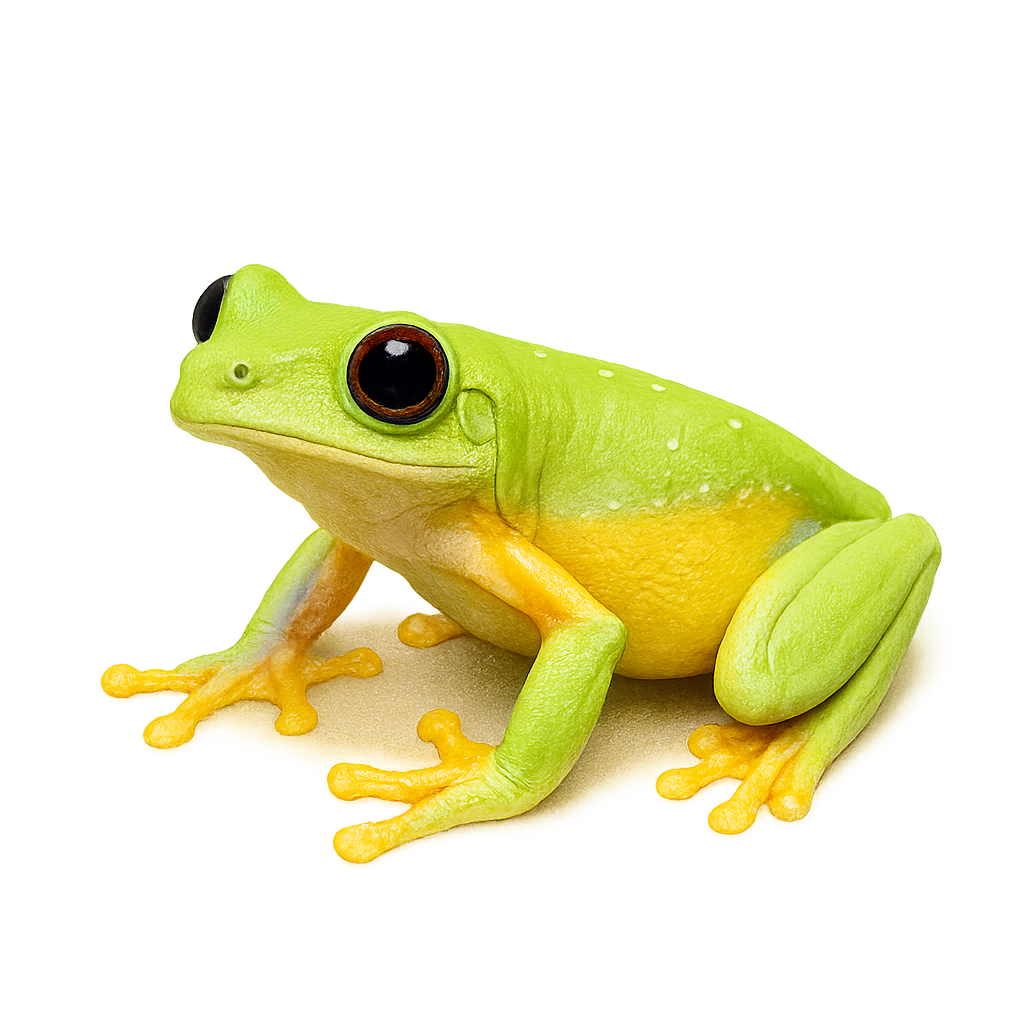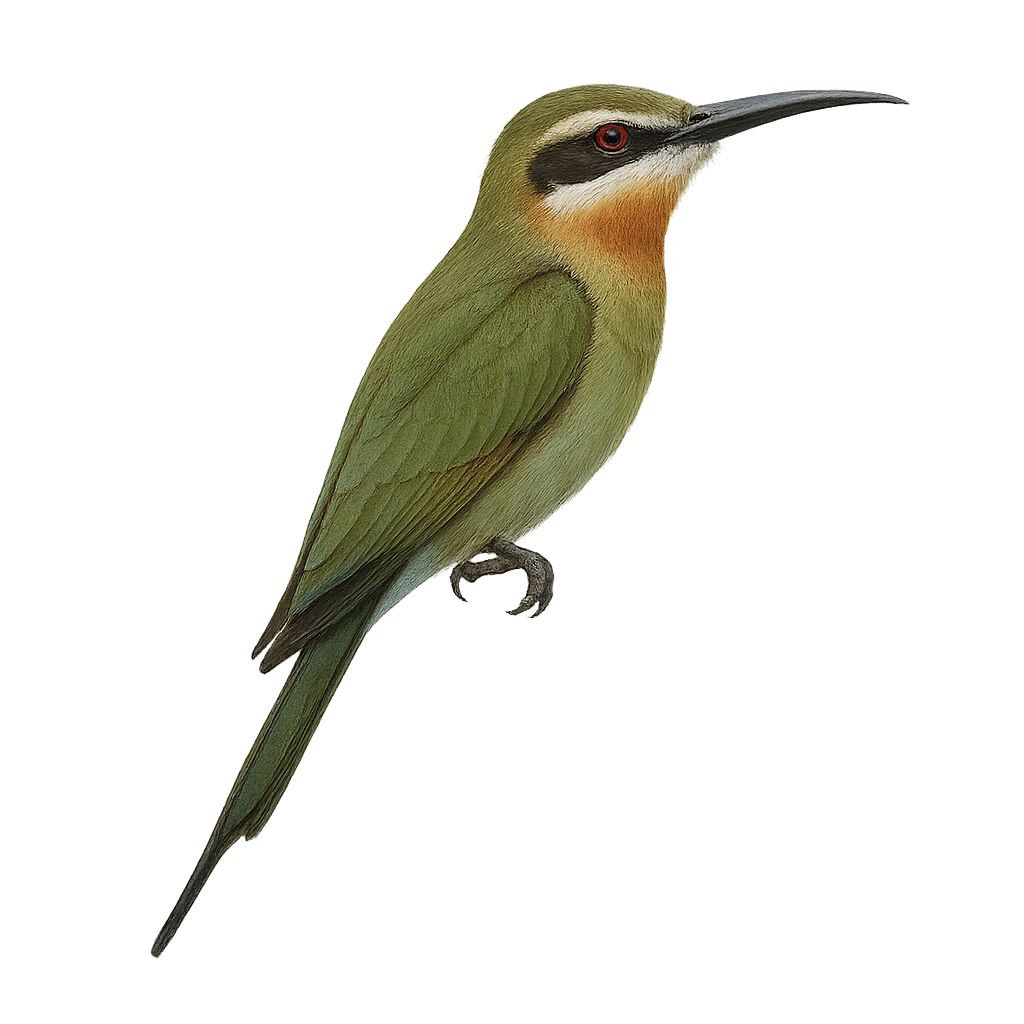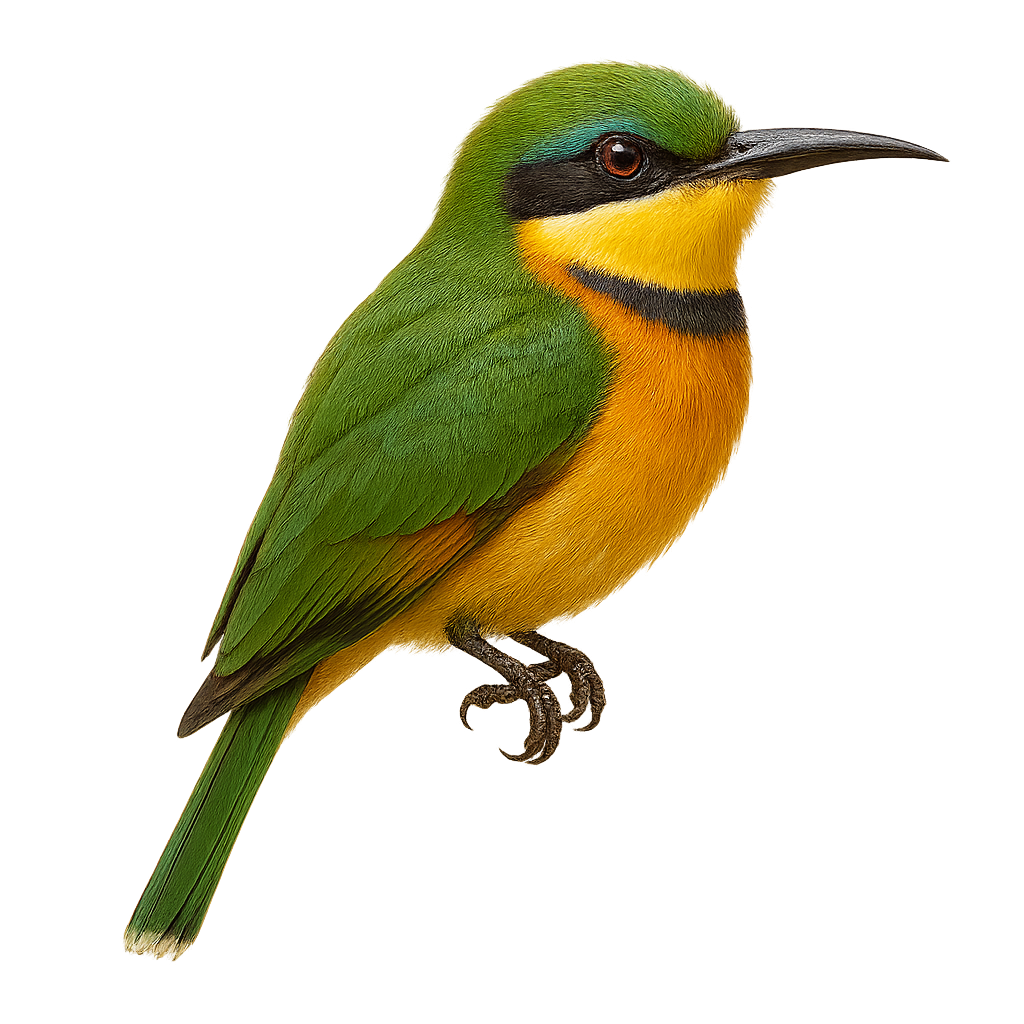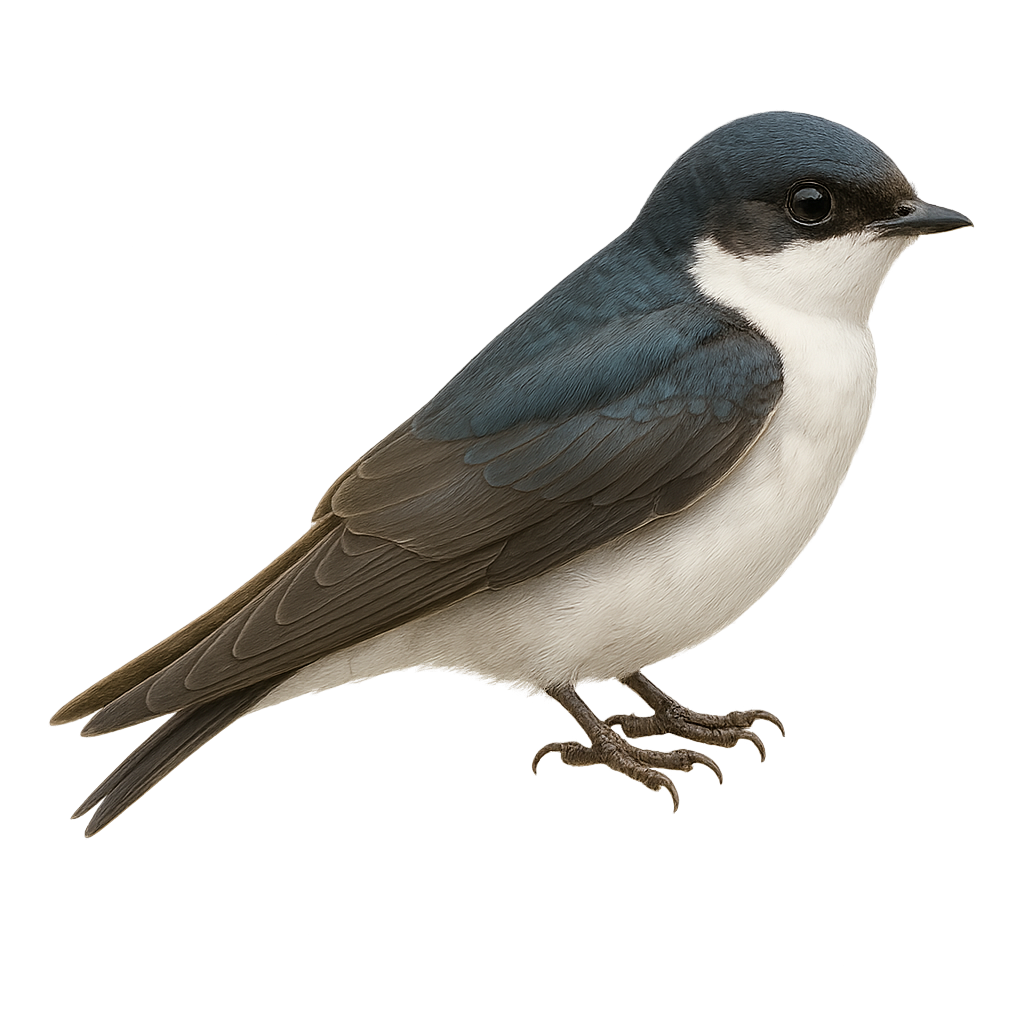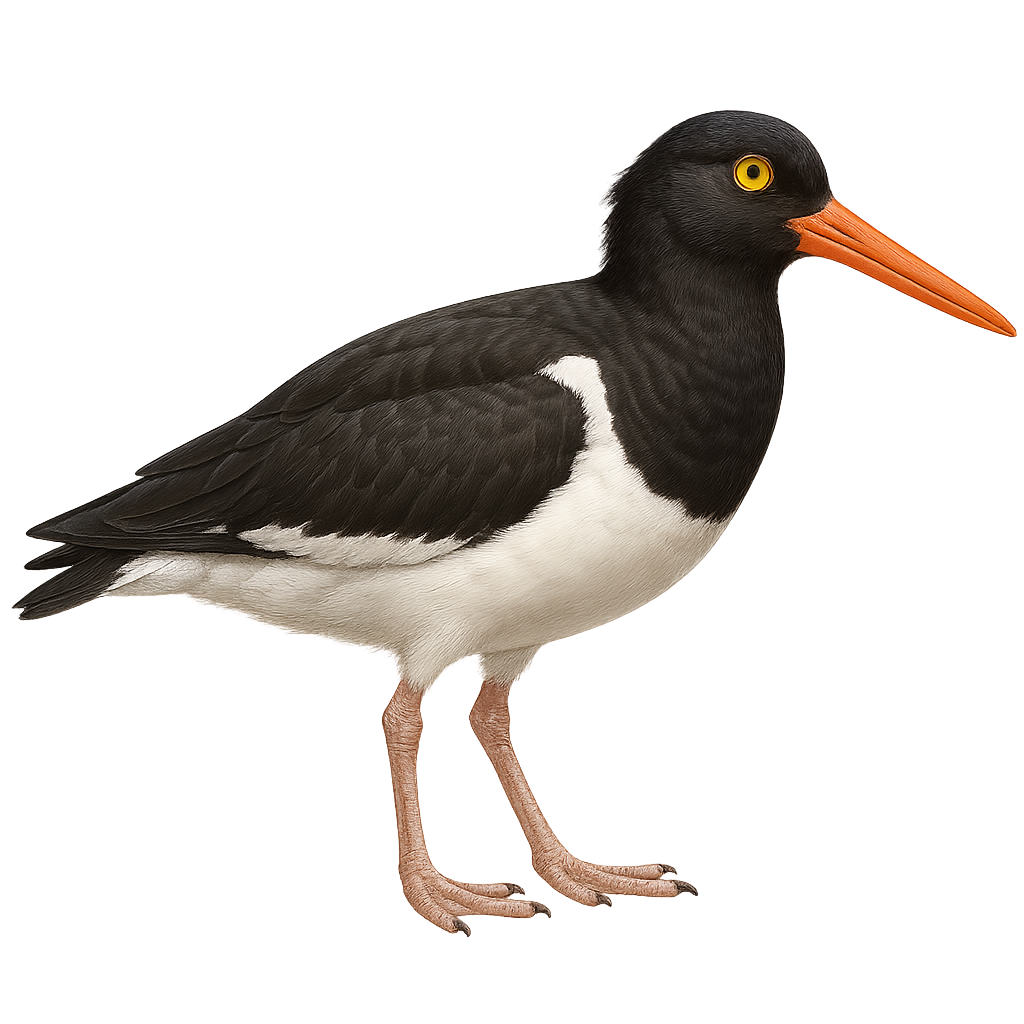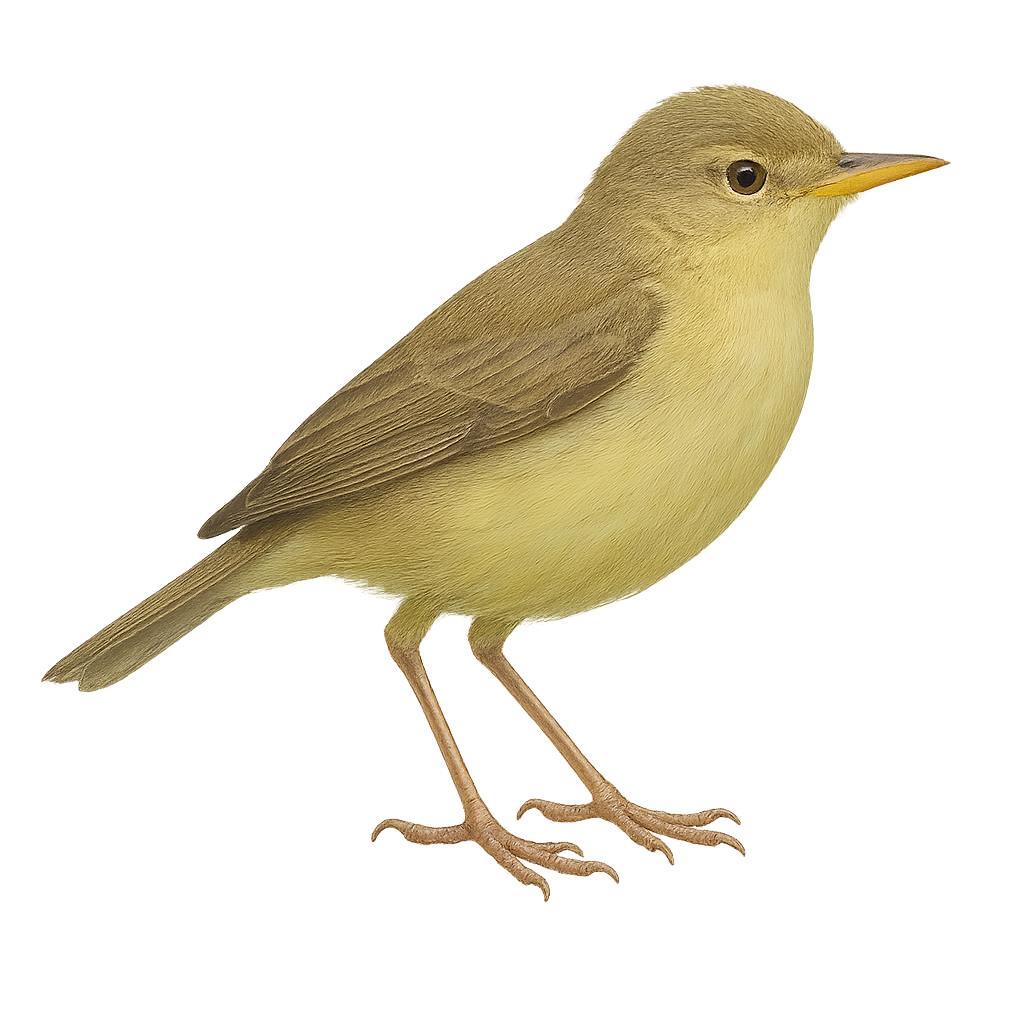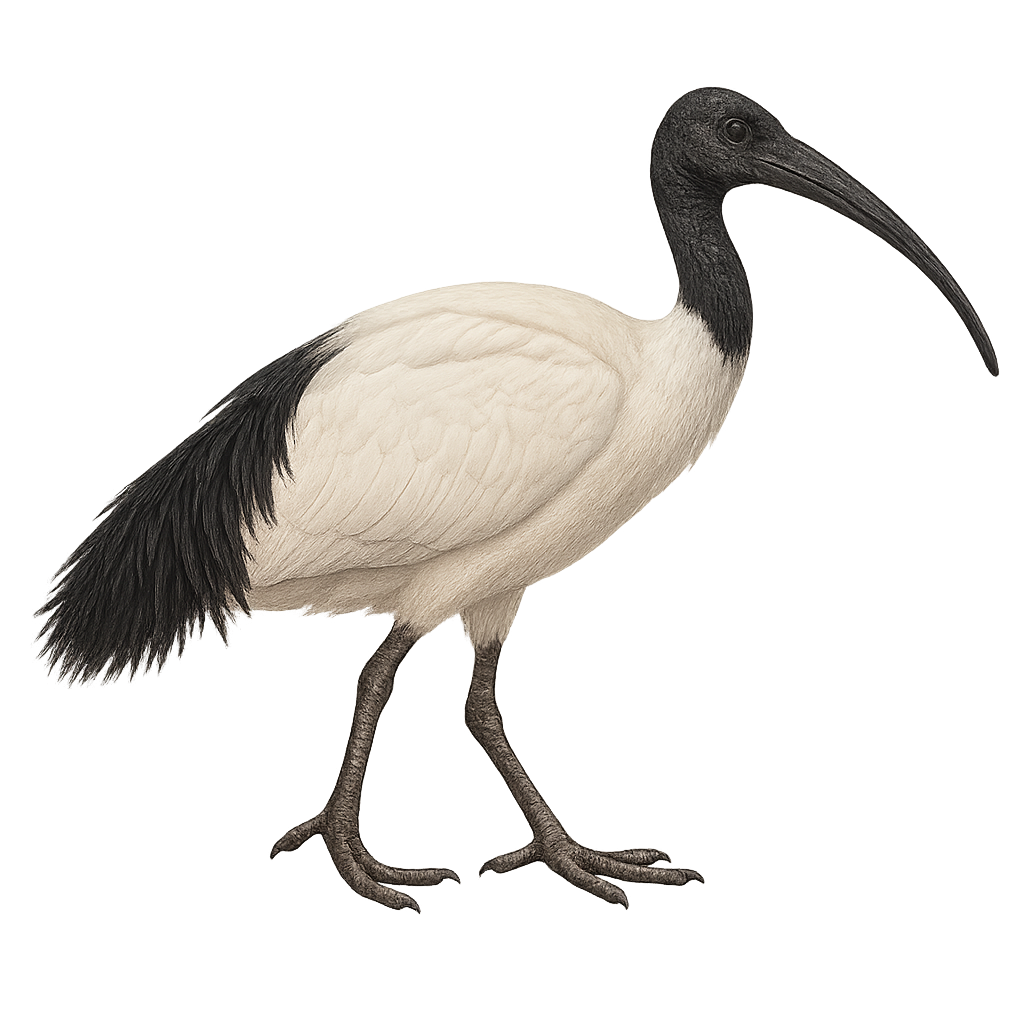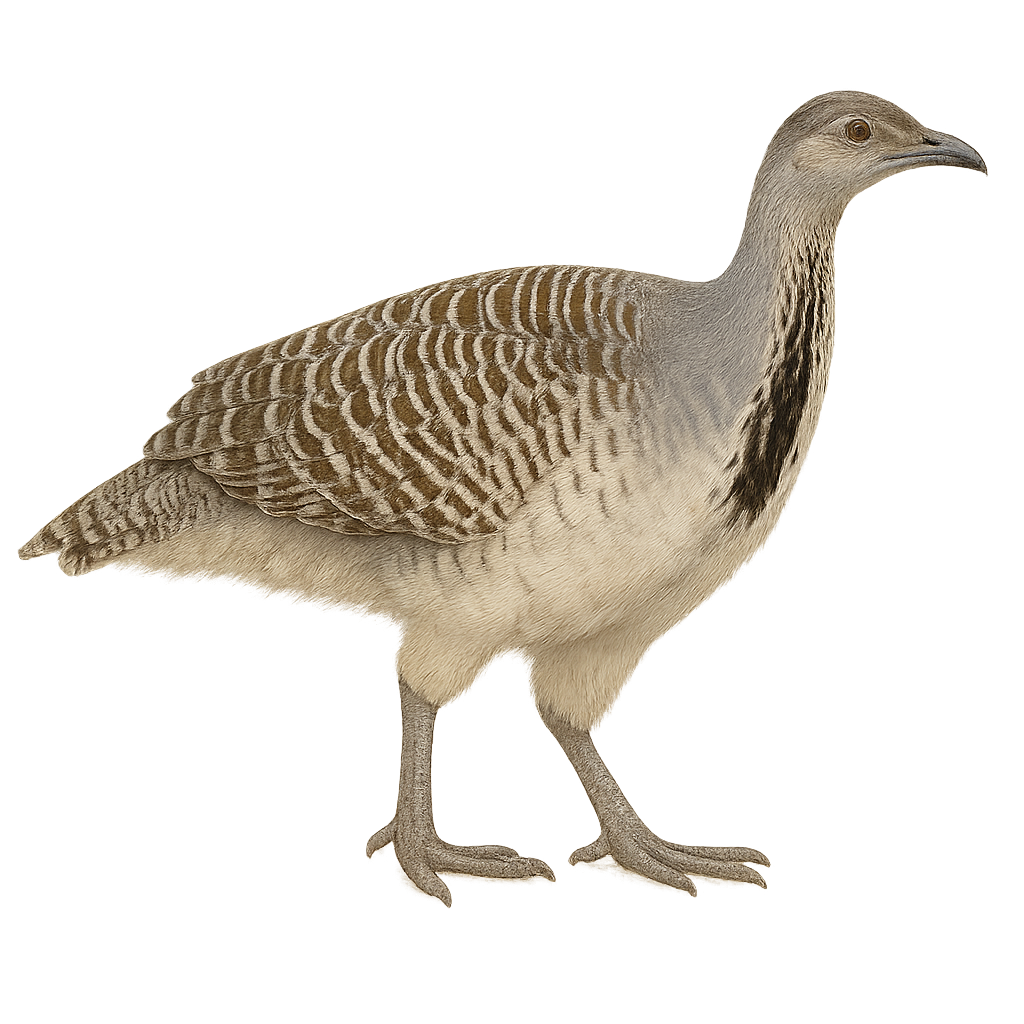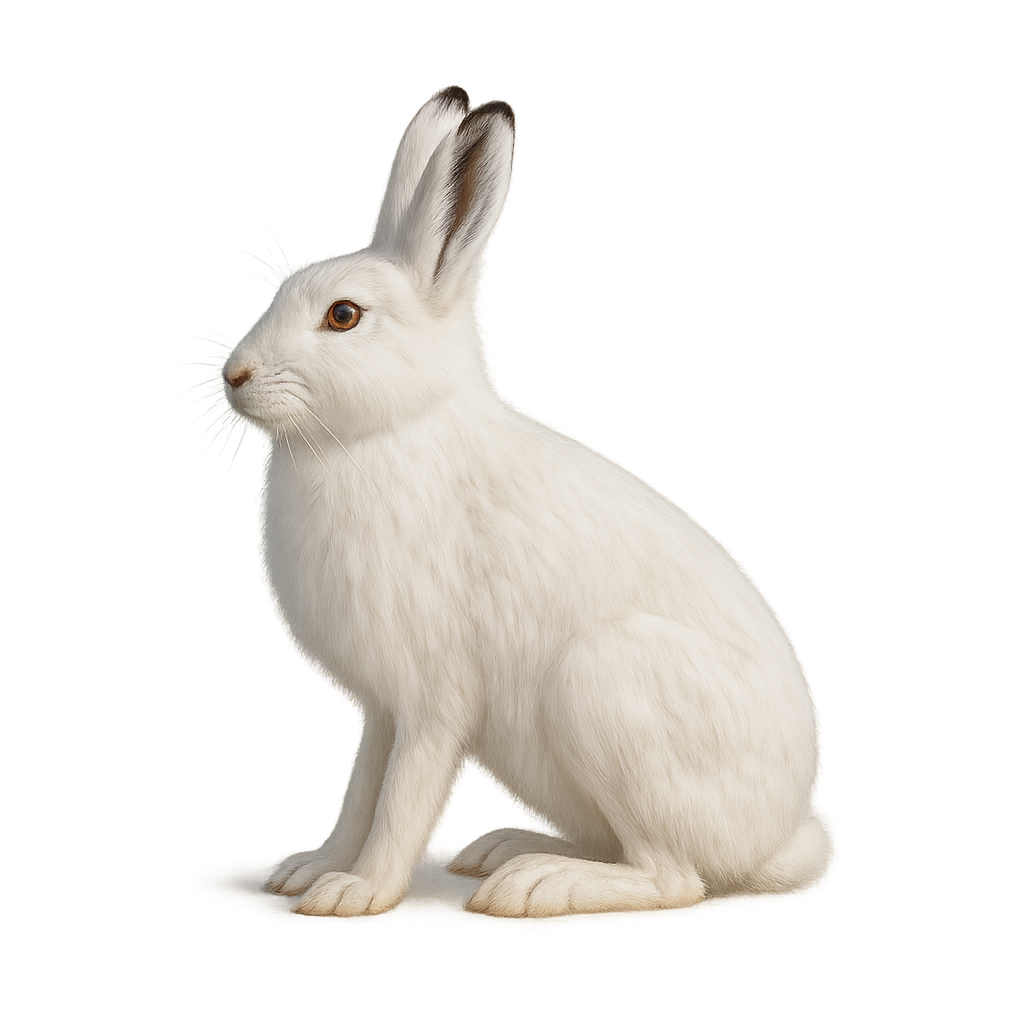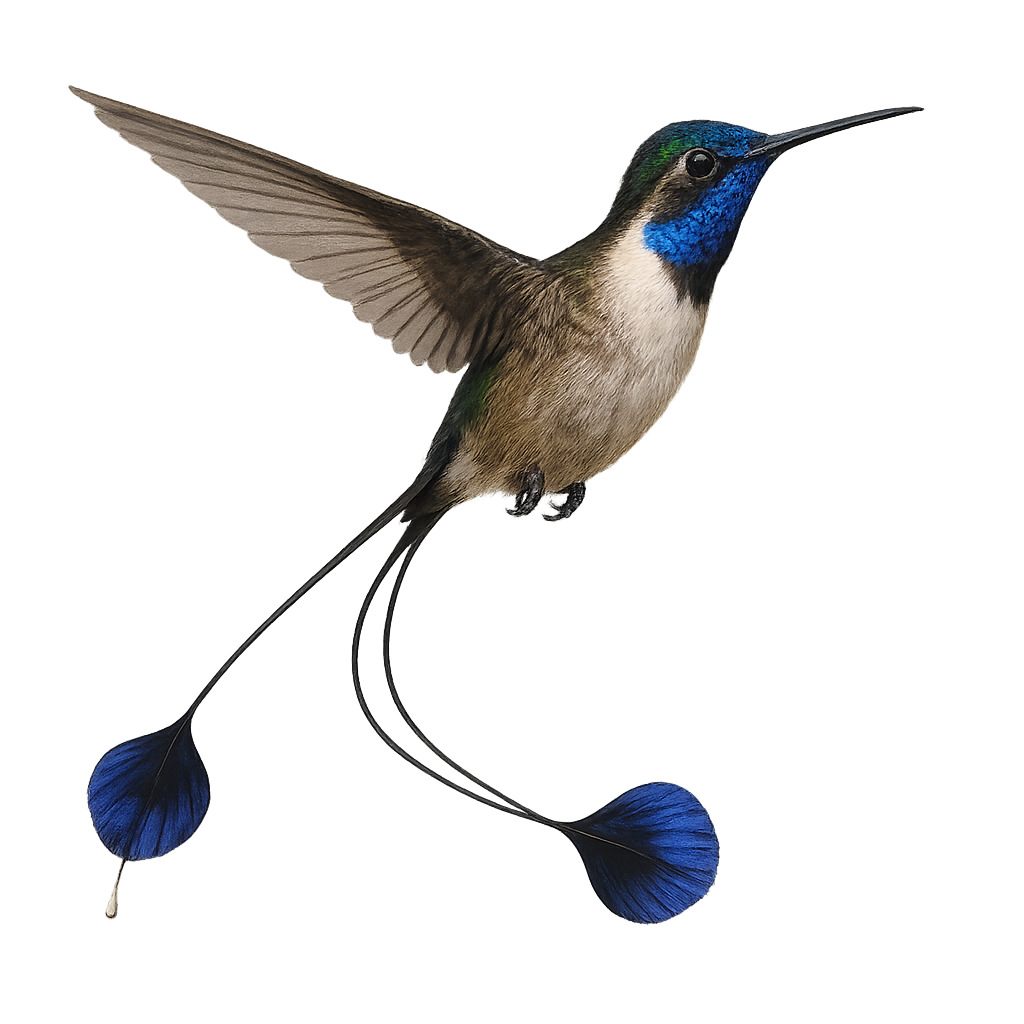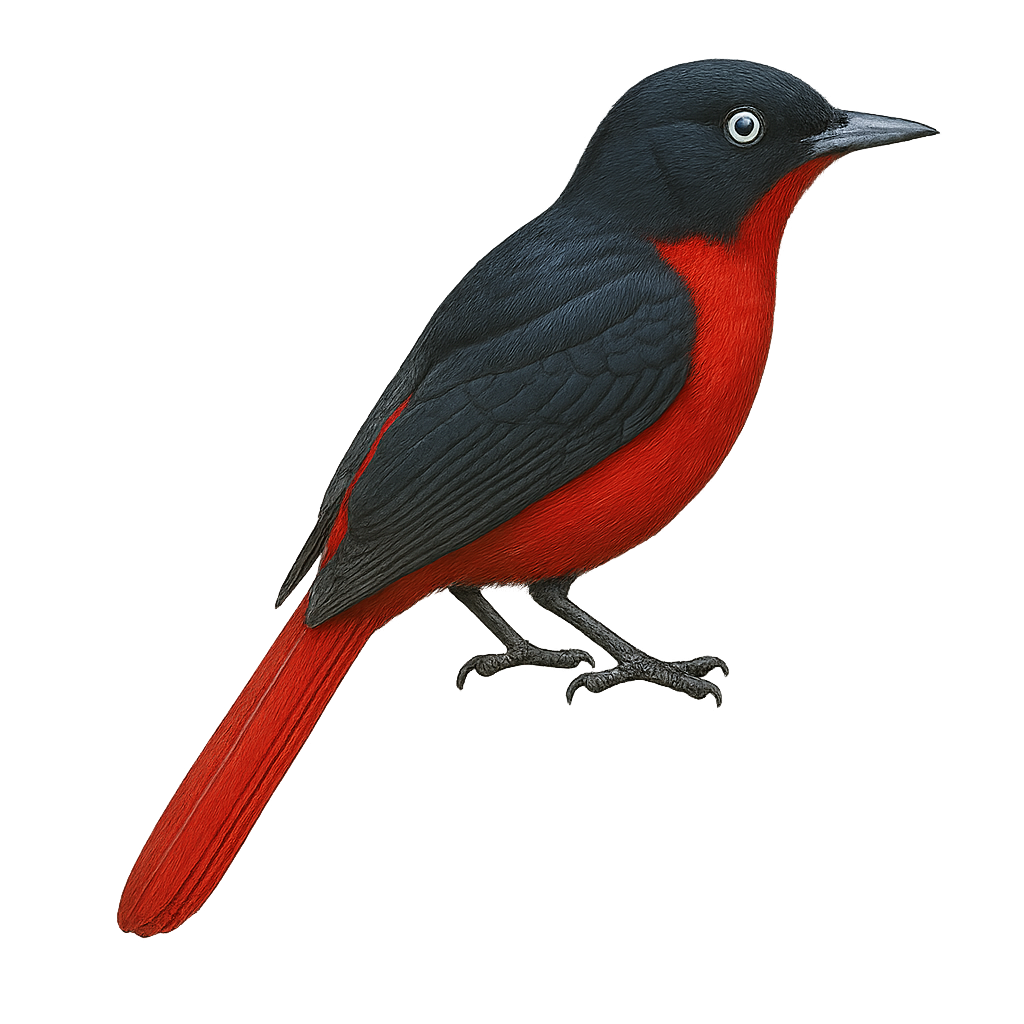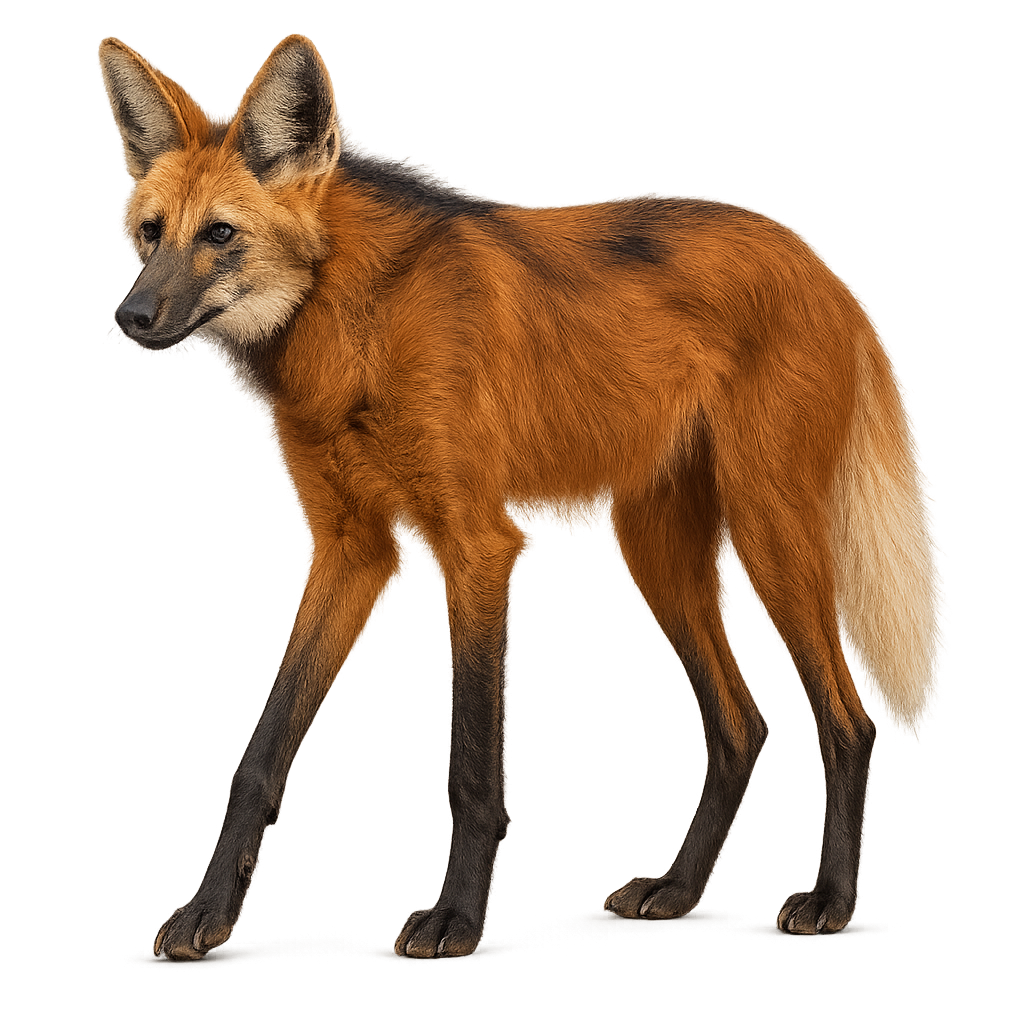The Mayotte Fody, or Foudia eminentissima, is a small bird endemic to the island of Mayotte in the Comoros archipelago. This passerine is notable for its bright red plumage in males, while females display more subdued shades of brown and gray. Measuring about 12 to 14 cm, it is often seen in forests, gardens, and cultivated areas. Its diet mainly consists of seeds, fruits, and insects. The Mayotte Fody is a social bird, often seen in small groups, and plays a crucial role in pollinating certain local plants. Although its habitat is limited, it adapts well to human-modified environments.
The magnificent frigatebird is an impressive seabird, recognizable by its slender silhouette and long, sickle-shaped wings. Males display a bright red gular pouch, which they inflate to attract females. These birds are primarily black with metallic sheens, and females are distinguished by a white breast. They are often seen soaring above tropical oceans, using air currents to move effortlessly. Frigatebirds do not swim and cannot take off from water, so they feed by catching flying fish or harassing other birds to steal their prey. Their wingspan can reach up to 2.3 meters, making them masters of gliding flight.
The mountain gazelle, or Gazella gazella, is a graceful herbivorous mammal primarily inhabiting the arid and semi-arid regions of the Middle East. It is distinguished by its light brown coat, paler flanks, and lyre-shaped, ringed horns. Males are generally larger and have longer horns than females. This species is well adapted to its dry environment, capable of surviving with minimal water by extracting necessary moisture from its food. It is mainly active at dusk and dawn, avoiding the extreme daytime temperatures. The mountain gazelle is a social species, living in small groups, but can also be solitary. It is known for its speed and agility, allowing it to escape natural predators.
The Mongolian gazelle, or Procapra gutturosa, is a species of gazelle primarily inhabiting the vast steppes of Mongolia and parts of China. It is recognizable by its light brown coat, which helps it blend into its arid surroundings. Males are distinguished by their ringed horns and thicker necks, especially during the rutting season. These gazelles live in large herds, which provide protection against predators. They are extremely agile and can run at high speeds to escape danger. Their diet mainly consists of grasses and low-lying plants, adapted to the harsh climatic conditions of their habitat.
The Phelsuma madagascariensis, or Madagascar day gecko, is a colorful and fascinating lizard native to Madagascar. It is renowned for its bright colors, often green with red and blue spots, which help it blend into its natural environment. Typically measuring between 20 and 25 cm, this gecko is diurnal, meaning it is active during the day. It primarily inhabits humid tropical forests but can also be found in gardens and plantations. Although mainly insectivorous, it also feeds on nectar and fruits. Its ability to climb smooth surfaces thanks to its adhesive pads makes it an excellent climber.
The Maasai Giraffe is a subspecies of giraffe, easily recognized by its irregular and jagged patches, which differ from those of other subspecies. It typically stands between 4.3 and 4.8 meters tall, with males being larger and heavier than females, weighing between 800 and 1,200 kg. Its coat is light beige to light brown, with irregularly shaped leaf-like patches that are bordered in white. These patches are smaller and more scattered than those of the Southern Giraffe. The Maasai Giraffe primarily inhabits the savannas and grasslands of East Africa, particularly in Kenya and Tanzania. It is herbivorous, feeding mainly on acacia leaves and other tall vegetation, which it reaches with its long neck and prehensile tongue. Although the Maasai Giraffe is currently considered less threatened than other giraffe subspecies, it faces threats such as habitat loss and poaching.
The Macaroni Penguin, Eudyptes chrysolophus, is a medium-sized penguin known for its striking yellow crest contrasting with its black and white plumage. It primarily inhabits subantarctic and Antarctic islands, forming large colonies on rocky slopes. This penguin is an excellent swimmer, capable of diving to impressive depths to hunt fish, krill, and crustaceans. Its breeding season begins in the austral spring, where pairs reunite to nest. Although its conservation status is concerning due to climate change and industrial fishing, the Macaroni Penguin remains a fascinating species that continues to captivate researchers and nature enthusiasts.
The mountain gorilla, Gorilla beringei beringei, is an iconic species primarily inhabiting the mountainous forests of the volcanic regions in Central Africa. Known for their thick fur, which is adapted to the cooler temperatures of their high-altitude habitat, these gorillas live in family groups led by a dominant male, known as a silverback. They are mainly herbivorous, feeding on leaves, stems, and fruits. Unfortunately, this species is critically endangered due to habitat loss, poaching, and disease. Conservation efforts are crucial for their survival, involving the protection of their natural habitat and raising awareness among local communities.
The Phelsuma grandis, or Madagascar giant day gecko, is a fascinating lizard native to Madagascar, known for its vibrant colors and impressive size, reaching up to 30 cm in length. Its skin is typically green with red and blue spots, allowing it to blend effectively into its natural habitat. This gecko is diurnal, meaning it is active during the day. It primarily feeds on insects, fruits, and nectar. In captivity, it is appreciated for its beauty and relatively docile behavior, although it requires a carefully controlled environment to thrive.
The Mountain Plover, Anarhynchus alticola, is a bird species primarily inhabiting mountainous regions. This plover is recognizable by its discreet plumage, usually gray-brown, which allows it to blend into its rocky environment. It is often observed in small groups, feeding on insects and small invertebrates. Its ability to survive at high altitudes demonstrates its remarkable adaptation to harsh conditions. Although its habitat is relatively isolated, it is vulnerable to human disturbances and climate change, which threaten its breeding and feeding areas. Conservation of this bird requires special attention to preserve its natural habitats.
The Mountain Plover, Anarhynchus montanus, is a fascinating bird primarily inhabiting mountainous regions. It is distinguished by its discreet plumage, often gray-brown, which allows it to blend into its rocky environment. This medium-sized plover has a short, straight bill, adapted to its diet mainly consisting of insects and small invertebrates. It is often observed in small groups, moving quickly on the ground in search of food. Although generally discreet, the Mountain Plover can be quite vocal, especially during the breeding season. Its preferred habitat includes alpine meadows and rocky plateaus, where it can nest safely from predators.
The Morelet's Tree Frog, scientifically known as Agalychnis moreletii, is a striking species of arboreal frog characterized by its smooth skin and vibrant colors. It features a bright green back and a white belly, with prominent red or orange eyes. This nocturnal frog is found in the humid tropical forests of Central America, particularly in Mexico, Belize, and Guatemala. It is often seen perched on tree branches near water bodies, where it breeds. The Morelet's Tree Frog is an endangered species due to habitat loss and water pollution. It plays a crucial role in the ecosystem by controlling insect populations.
The Excidobates mysteriosus, commonly known as the Marañón poison frog, is a fascinating species from the Dendrobatidae family. It is endemic to the humid tropical forests of Peru, where it primarily inhabits dense undergrowth and areas near water streams. Its skin is a deep blue with distinctive black patterns, making it easily recognizable. Despite its beauty, it is difficult to observe due to its discreet nature and restricted habitat. This species is diurnal and primarily feeds on small insects. It plays a crucial role in the ecosystem by controlling insect populations. The mysterious frog is currently classified as vulnerable due to the loss of its natural habitat.
The mistle thrush is a ground-dwelling bird found primarily in open woodlands, hedgerows, and cultivated areas across Europe and Asia. It is distinguished by its grey-brown plumage and dark spots on its belly. The mistle thrush is particularly known for its aggressive behavior when defending its territory, emitting loud songs and harsh calls. It primarily feeds on berries, fruits, and small insects.
The Madagascar Bee-eater, Merops superciliosus, is a colorful and fascinating bird, primarily found in Madagascar and parts of East Africa. It is distinguished by its vibrant plumage, featuring shades of green, blue, and rufous, as well as its long, slender tail. This bird is often seen in flight, catching insects mid-air with its thin, curved beak. It typically nests in burrows dug into sandy banks, forming noisy and dynamic colonies. The Madagascar Bee-eater is a diurnal bird, active mainly during the day, and is known for its social behaviors and spectacular courtship displays.
The Mountain Bee-eater, Merops oreobates, is a colorful and fascinating bird belonging to the Meropidae family. It is primarily found in the mountainous regions of East Africa, where it inhabits montane forests and wooded areas. Its vibrant plumage, featuring shades of green, blue, and yellow, makes it easily recognizable. This bird primarily feeds on insects, especially bees and wasps, which it catches in flight with remarkable agility. The Mountain Bee-eater is a sociable bird, often seen in small groups. It nests in burrows dug into banks or sandy slopes. Although its conservation status is currently stable, deforestation and habitat loss could threaten its populations in the future.
The Marbled Murrelet, Brachyramphus marmoratus, is a discreet and fascinating seabird belonging to the Alcidae family. It is primarily observed along the North Pacific coasts, from Alaska to California. This small bird, measuring about 25 cm in length, is recognizable by its marbled brown and white plumage, which allows it to blend effectively into its environment. Unlike most other alcids, the Marbled Murrelet nests in old-growth forests, often several kilometers from the sea, where it lays a single egg on a tree branch. It primarily feeds on small fish and marine invertebrates, which it skillfully captures by diving underwater. Unfortunately, this species is threatened by the loss of its forest habitat and human disturbances.
The Mangrove Swallow, Tachycineta albilinea, is a small, elegant bird found in the neotropical regions. It is characterized by its iridescent blue-green back and white underparts. This species is often seen near water bodies like rivers, lakes, and mangroves, where it skillfully hunts flying insects. Known for its rapid and acrobatic flight, it often flies in small groups. Nests are typically built in natural or artificial cavities, with the female laying three to five eggs. Although its habitat is threatened by deforestation and pollution, it is currently classified as Least Concern by the IUCN.
The Magellanic Oystercatcher, or Haematopus leucopodus, is a distinctive coastal bird known for its black and white plumage and bright red bill. It primarily inhabits rocky shores and pebble beaches in southern South America, particularly in Patagonia and Tierra del Fuego. This bird is an excellent forager, using its strong bill to pry open shells and feed on mollusks and crustaceans. Magellanic Oystercatchers are monogamous and highly territorial, vigorously defending their nesting territory from intruders. Their nest is often a simple scrape in the ground, where they typically lay two to three eggs. Although they are relatively tolerant of human presence, it is important to respect their space to avoid disturbing their natural behavior.
The melodious warbler is a small migratory passerine of 11–13 cm with olive-yellow upperparts and pale yellow underparts. It inhabits open woodlands, hedgerows and groves, feeding mainly on insects captured in flight or among foliage. During breeding, males sing from elevated perches to attract females and defend territory.
The Malagasy sacred ibis, or Threskiornis bernieri, is a bird species endemic to Madagascar, primarily found in coastal wetlands and mangroves. This medium-sized bird, recognizable by its white plumage contrasting with its black head and neck, is often seen in small groups. It feeds mainly on small invertebrates, fish, and crustaceans, which it finds by probing the mud with its long, curved bill. Deforestation and habitat degradation are major threats to its survival. Classified as vulnerable by the IUCN, the Malagasy sacred ibis is the focus of conservation programs aimed at protecting its habitats and raising awareness among local populations about its ecological importance.
The Marine Iguana is a unique species found exclusively on the Galápagos Islands. This iguana is the only reptile to have adapted to aquatic life, feeding on marine algae that it collects underwater while diving. It has a distinct morphology with a robust body and a long tail, allowing it to swim efficiently. Marine iguanas are often seen basking on rocks in the sun to regulate their body temperature after their dives into cold water. This thermal hibernation behavior is essential for their survival in the Galápagos environment.
Matschie’s tree kangaroo is a medium-sized marsupial, 60–80 cm long (excluding tail), with reddish-brown fur and a long prehensile tail. Endemic to humid montane rainforests of the Huon Peninsula in Papua New Guinea (1000–3000 m), it spends most of its time in the canopy feeding on fruits, leaves, and insects. Solitary and elusive, it moves nimbly among branches thanks to strong limbs and a long tail.
The Mealy Amazon, or Amazona farinosa, is a large parrot, measuring about 38 to 41 cm in length. Its plumage is primarily green, with bluish hues on the forehead and yellow touches on the wings. This species is known for its ability to mimic sounds and human voices, making it a popular pet bird. It mainly inhabits the tropical rainforests of Central and South America, where it feeds on fruits, seeds, and flowers. Although sociable, it can be noisy, especially in groups. The Mealy Amazon is currently classified as "Least Concern" by the IUCN, but it is threatened by deforestation and illegal trade.
The Leipoa ocellata, or Malleefowl, is a unique terrestrial bird endemic to the arid and semi-arid regions of Australia. This medium-sized bird, measuring about 60 cm in length, is easily recognizable by its brown plumage speckled with white and black, allowing it to blend into its surroundings. It is famous for its unusual breeding method: the male builds a large mound of earth and vegetation, where the female lays her eggs. The heat generated by the decomposition of organic matter incubates the eggs. The Malleefowl is a discreet bird, often difficult to observe, as it prefers to move on foot and quickly hides when threatened.
The Mountain Hare is a small mammal, easily recognizable for its ability to change color according to the seasons. In winter, its coat becomes completely white, allowing it to blend perfectly into the snow, while in summer, it has a brown or gray coat, with darker shades on its back and lighter hues on its belly. It measures about 50 to 70 cm in length, with a tail of 6 to 8 cm, and weighs between 2 and 4 kg. The Mountain Hare is primarily found in the cold, mountainous regions of Northern Europe, Northern Asia, and certain mountainous areas of North America. It is a herbivorous animal that feeds on a variety of vegetation, primarily grasses, roots, fruits, and young shoots. It is mainly active at dusk and during the night, hiding in bushes or under grasses during the day. Although it is quite resilient to cold temperatures, the species is threatened by habitat loss and climate changes affecting its natural environment.
The Marvelous Spatuletail, or Loddigesia mirabilis, is a fascinating and rare bird endemic to Peru. This hummingbird is famous for its spectacular tail feathers, which end in racket-shaped spatules. Males display vibrant plumage with bright colors, while females are more subdued. They primarily inhabit cloud forests and wooded areas at altitudes between 2100 and 2900 meters. Their diet mainly consists of nectar, which they extract while hovering, and insects. Their behavior is generally suspicious, making them a challenge for birdwatchers and photographers to observe.
The Maroon Oriole, or Oriolus traillii, is a striking bird known for its vibrant plumage and elusive presence in the forests of Southeast Asia. With colors ranging from bright red to deep black, it blends skillfully into dense foliage. This bird is primarily arboreal, feeding on fruits, insects, and nectar. Its melodious song often echoes through the trees, although spotting it remains a challenge for birdwatchers. The Maroon Oriole is a partial migrant, moving according to seasons to find food resources. It builds suspended nests, often well-hidden, where it carefully raises its young.
The Maned Wolf is a large carnivore native to South America, particularly known for its distinctive mane that surrounds its neck, giving the animal a majestic and unique appearance. It measures about 1 meter in body length, with a tail of about 30 to 40 cm, and weighs between 20 and 30 kg. Its coat is generally orange or golden in color, with darker shades on the head and legs, and a dark mane extending along its neck and throat. The Maned Wolf primarily inhabits the prairies and open savannas of Brazil, especially in the Pantanal region. It is an opportunistic predator, mainly feeding on small mammals, birds, and reptiles, but it can also consume fruits and plants. This wolf is an excellent runner and uses its speed to capture prey. Although the Maned Wolf is little known, it is an endangered species due to habitat loss, cattle trampling of land, and diseases. Conservation efforts are in place to protect this unique species.
The Magellanic Penguin, Spheniscus magellanicus, is a species of penguin found primarily along the coasts of South America, particularly in Argentina, Chile, and the Falkland Islands. This medium-sized penguin stands about 70 cm tall and weighs between 3 and 6 kg. It is easily recognizable by its black and white plumage, with two distinctive black bands around its neck and chest. Magellanic Penguins are marine birds that primarily feed on fish and crustaceans. They are known for their long annual migrations, sometimes traveling thousands of kilometers to find breeding and feeding grounds. Although they are socially tolerant, they can be aggressive when defending their nests.


